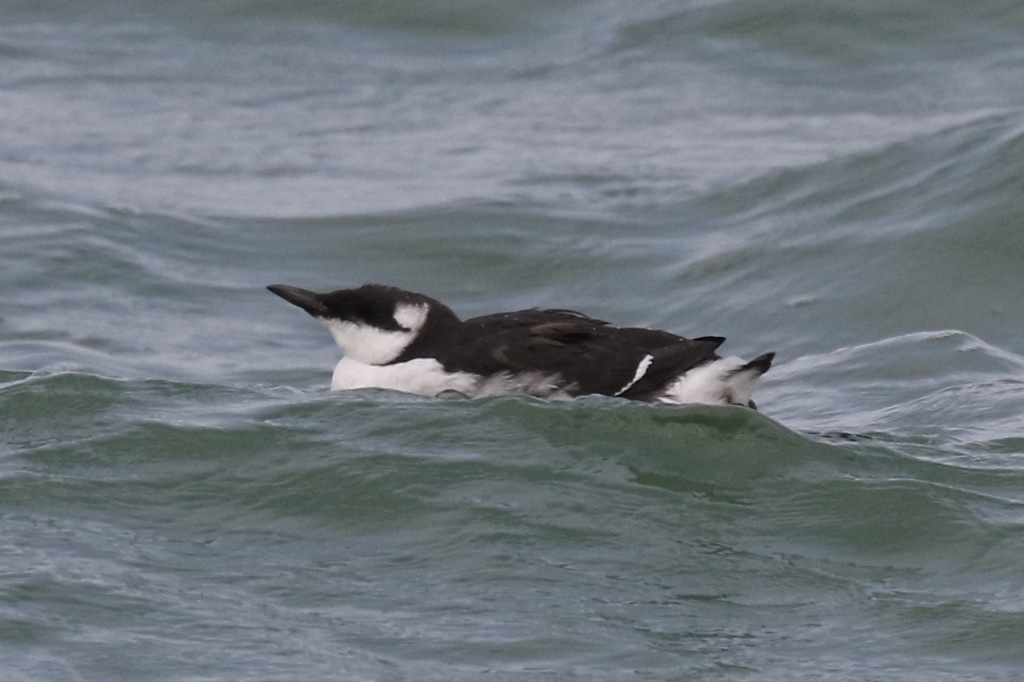A Private Tour today, along the North Norfolk coast. It was mostly cloudy but bright with some nice sunny intervals which were not in the forecast.
Winds from the NE can sometimes bring drift migrants from Scandinavia at this time of year. There had been a few earlier in the week, so we decided to have a quick look in Wells Woods first thing, to see if anything new had arrived overnight. As we walked in past the boating lake, we stopped for a quick scan – there were a few Little Grebes and a couple of Tufted Ducks out on the water.
As we forked right along the path to head into the trees, we heard a Kingfisher call from the pines beside us. We just caught sight of it, a flash of electric blue, as it zipped out across the track behind us and disappeared over the reeds towards the lake. A Red Admiral was sunning itself on the reeds by the path.
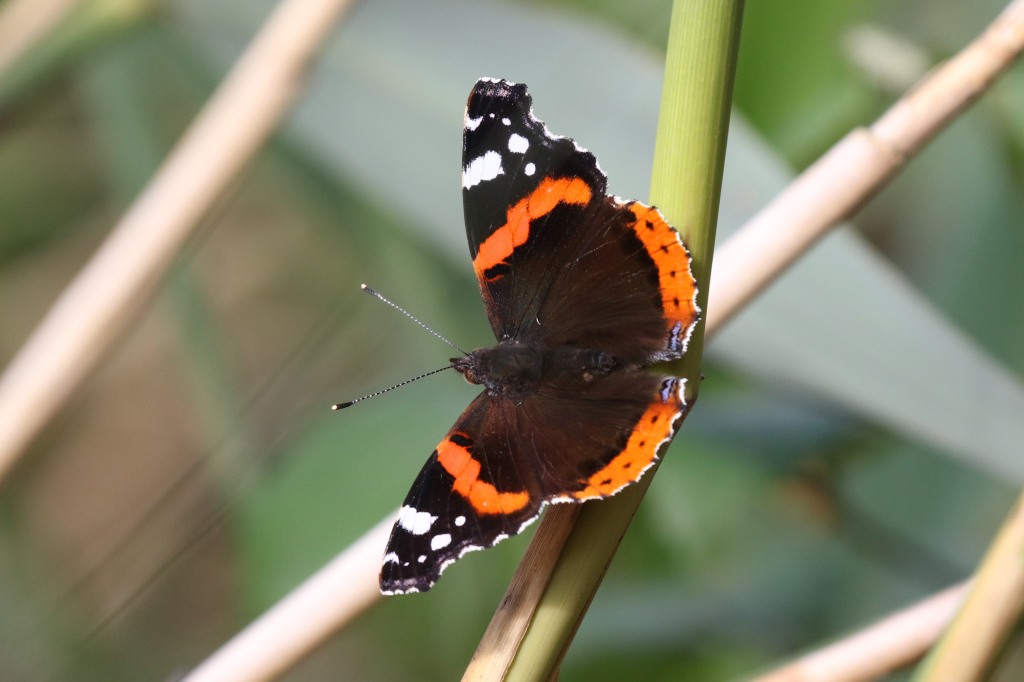
As we walked into the birches, we could hear tits in the trees and realised we were in the middle of a tit flock. There were lots of birds, so we stopped for a while to look through them. As well as the tits – Blue & Great Tits, Coal Tits, Long-tailed Tits – there was a selection of warblers, Chiffchaffs and a couple of lemon yellow Willow Warblers probably from Scandinavia, several Blackcaps and a single Garden Warbler briefly eating honeysuckle berries. A Treecreeper flew across but disappeared into the pines.
As the flock moved away from us, back towards the boating lake, we decided to venture in a little further. As is often the case in here at this time of year, it is largely all or nothing, and away from the tit flock the trees were rather quiet. We did come across a smart Jay which lingered long enough for us to get a good look at it on the north edge of the Dell.
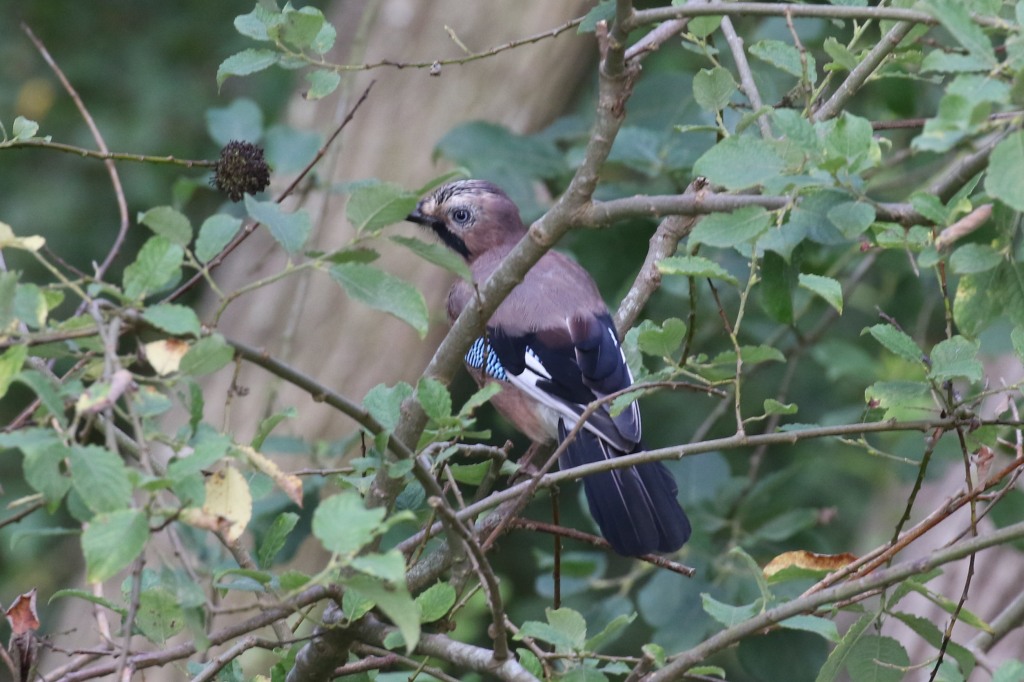
We walked across to try the open area south of the main track next. We could hear a couple of Lesser Whitethroats tacking quietly from the bushes and as we walked through two Common Whitethroats flew in and landed in the brambles beside us. We watched them eating the blackberries, admiring their bright rusty wing edges. There was no sign of a significant arrival of migrants overnight though, so we decided to head back round the other side of the Dell and move on.
The tit flock was still in the birches. We stopped as we could hear Bullfinches calling and watched them fly across to a tangle of briar and hawthorn on the edge of the trees. It was sunny in there and probably as a consequence there were lots of birds. We could still see the Bullfinches, and a juvenile plain-faced rusty juvenile posed nicely. A Garden Warbler, possibly the one we had seen briefly earlier, was busy preening deep in the branches. There were also a couple of Blackcaps and a Sedge Warbler, which looked rather out of place in here.
From Wells, we headed east along the coast to Cley. We had thought about walking up Blakeney Point, but it slowly became clear that some of the more interesting birds which had been there yesterday had cleared out overnight. It had been clear in the evening yesterday, and we had waited for news as we suspected that birds might have moved on.
We decided to head out to the hides before lunch. We started in Teal Hide, where we were told a couple of Little Stints had just disappeared into the back corner behind some reeds. As we set up the scope to look for them, we noticed movement on the edge of the reeds beyond – a juvenile Bearded Tit was working its way along, just above the mud.
Thankfully the Little Stints didn’t take long to reappear, and we had a good view of them through the scope, feeding with a small group of Dunlin. What was probably a Wood Sandpiper was not so obliging, disappearing out of view as we walked into the hide and not coming out again while we were there. There were lots of Black-tailed Godwits and Ruff on here too.
Dauke’s Hide is still closed (due to nesting Swallows!), so we went into Avocet Hide instead and scanned Simmond’s Scrape from there. There was a third Little Stint on here, with another flock of Dunlin, a better view too as it was a bit closer, picking around the back edge of one of the islands. We could really see how small it was.
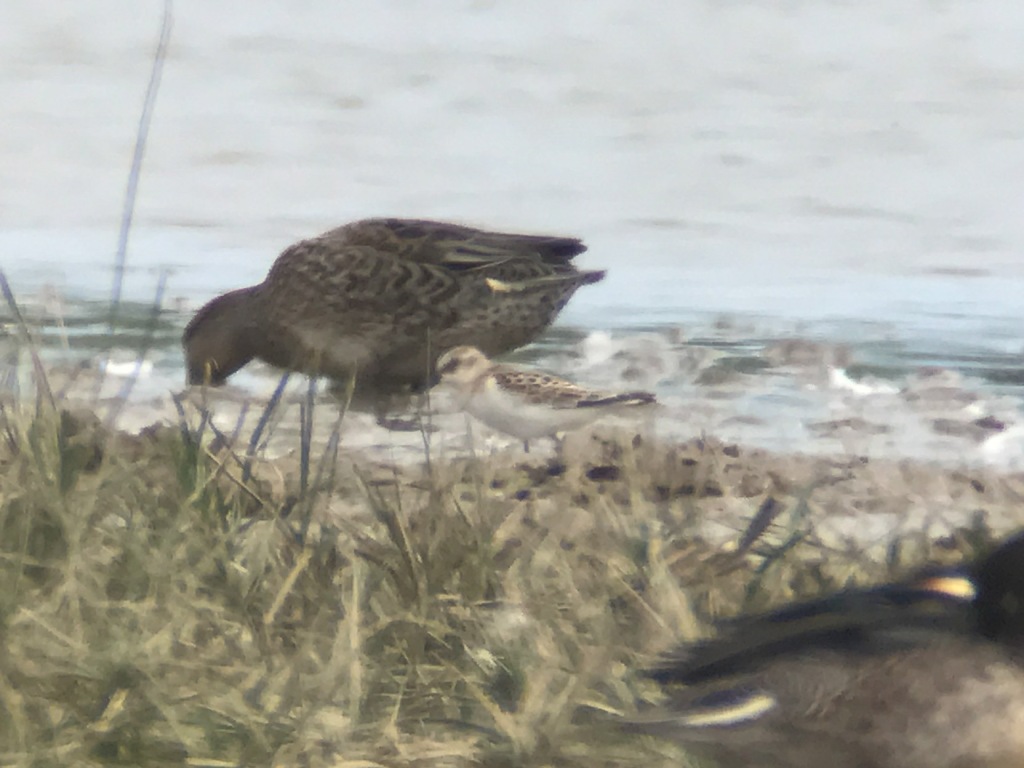
There was a good selection of other waders on Simmond’s too today. A Green Sandpiper was feeding along the edge of the reeds, where a Common Snipe was initially hiding, before it came out into full view on the island, giving us a great view through the scope. A Greenshank was in the water in the back corner, with a group of Black-tailed Godwits.
We made our way back to the Visitor Centre and ate our lunch on the picnic tables outside. There were a couple of options for the afternoon – a Barred Warbler was still on Blakeney Point, only about halfway up, and a Red-backed Shrike was still at Salthouse. The Barred Warbler had been very elusive yesterday and speaking to people who had been up this morning it was no easier today. There was no guarantee we would be able to find it, but the vote was to try anyway as that would give the opportunity to see a bit of Blakeney Point, a new destination for the members of the group. We might see some other things on the way too.
As we set off from the beach car park, we flushed a few Linnets from the shingle and a Reed Bunting was hopping around on the edge of the suaeda. A couple of Greenshanks kept coming up out of the muddy channel on the landward side and flying on ahead of us. A Golden Plover flew in over the harbour calling, and out over the shingle ridge.
There were obviously not many new migrants in here today, but we did come across a single Whinchat, feeding with a small group of Stonechats. They kept perching on the bushes and spikes of vegetation on the shingle ridge, flying on ahead of us as we walked.
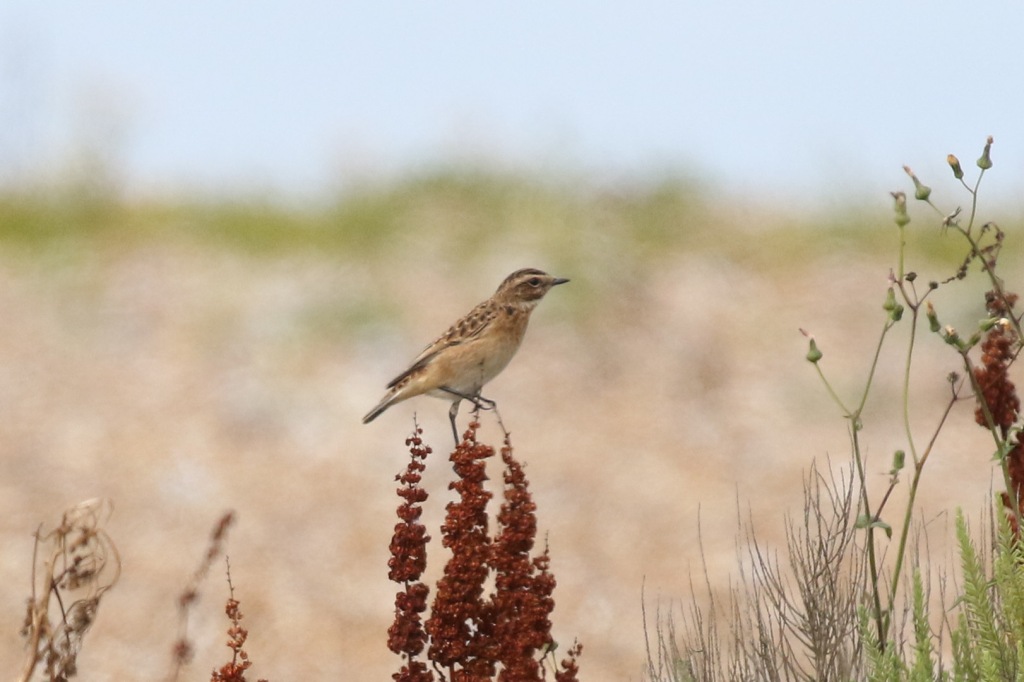
There were a few butterflies out here too, this afternoon. The highlight was a single Grayling which flew up from our feet. Landing again and folding its wings, it was very well camouflaged against the shingle. A Small Copper landed next to us while we were distracted by the Grayling. A male Common Blue fluttered furiously after a female around our legs.
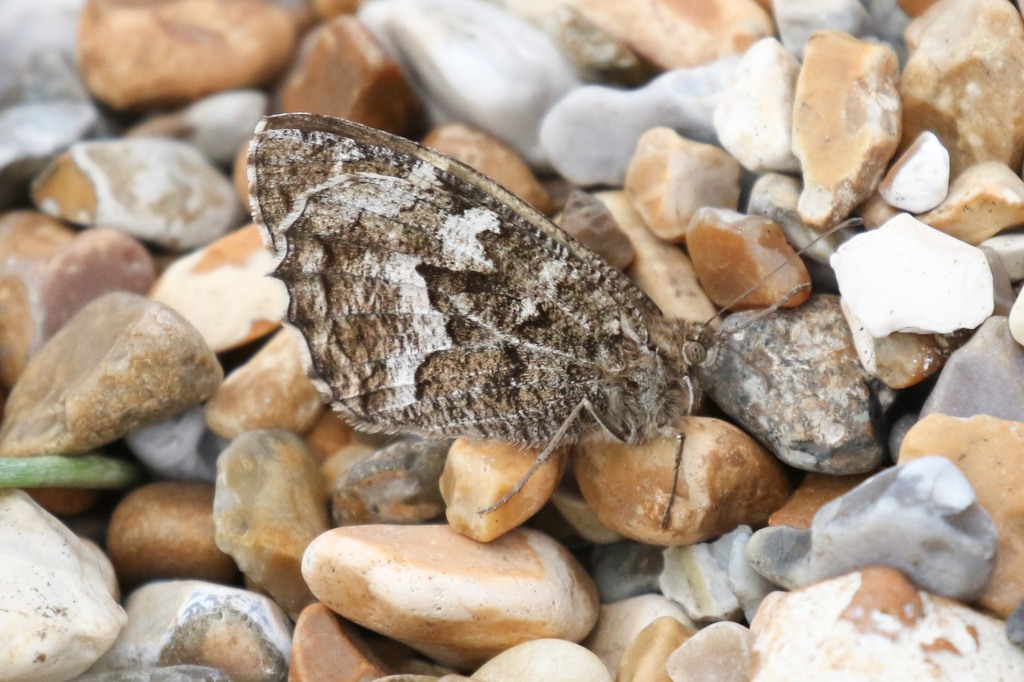
We stopped occasionally to look at the unique flora of the Point too, as we walked out. We managed to find one Yellow Horned-poppy which was still in flower, and admired the aroma of the Sea Wormwood. Not much is in flower now apart from the sea lavender, but we did also find Sea Campion, Sea Sandwort and of course lots of Suaeda vera.
When we got to the Watch House, traditionally known as ‘Halfway House’ to birders who make the long pilgrimage out to the end of the Point, there were only three people looking for the Barred Warbler and it hadn’t been seen for some time. The others wandered off but undaunted, we set off through the thickest patch of Suaeda. We hadn’t gone too far before it flew out in front of us. We got in position, and when it flew again, we all had a good view – a strikingly large and pale grey warbler with a long tail. We called the others back and everyone got to see the Barred Warbler now as it flew out and back into the Suaeda another couple of times. But it clearly wasn’t going to perch out in view today, and kept dropping into the deep vegetation, so we decided to leave it in peace to feed.
As we walked back towards the shingle ridge, we suddenly found we were surrounded by small bees with brightly banded abdomens, buzzing low over the short grass. We were in the middle of a colony of Sea Aster Bees (Colletes halophilus), which make their nesting burrows in the sandy ground by the path.
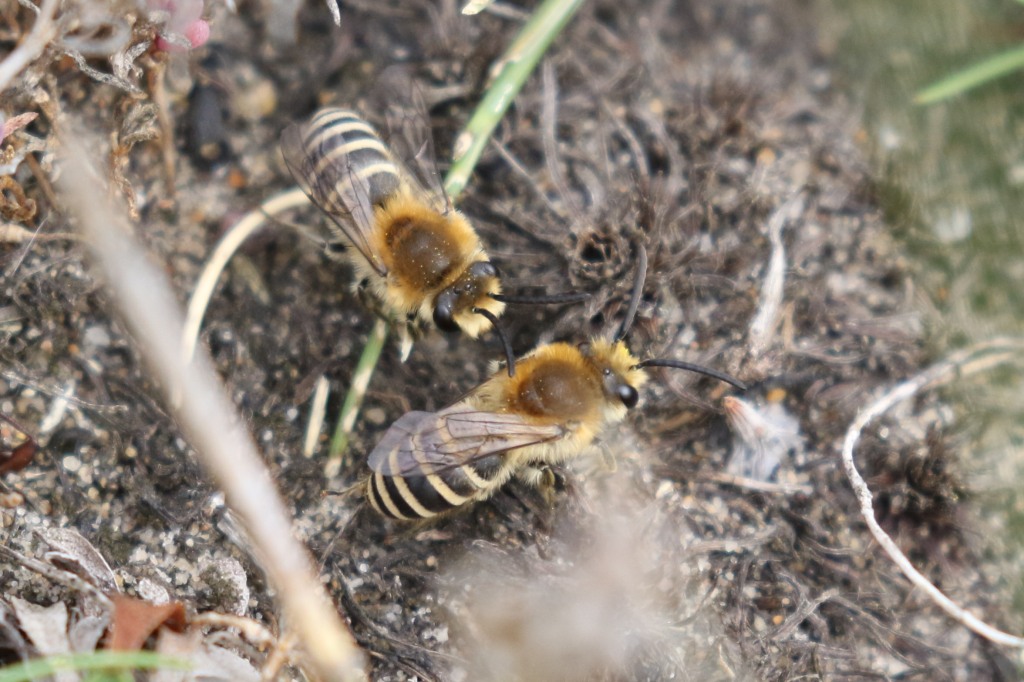
Sea Aster Bees (Colletes halophilus) – nesting by the path
As we looked at the Sea Aster Bees, we noticed a different bee in with them, with orange-red legs and eyes and white spots on the sides of its black abdomen. It was a Black-thighed Epeolus (Epeolus variegatus) a cleptoparasitic bee species which lays its eggs in the nest cells of the Sea Aster Bees. It was hanging around the openings of the nest burrows, presumably looking for active nests.
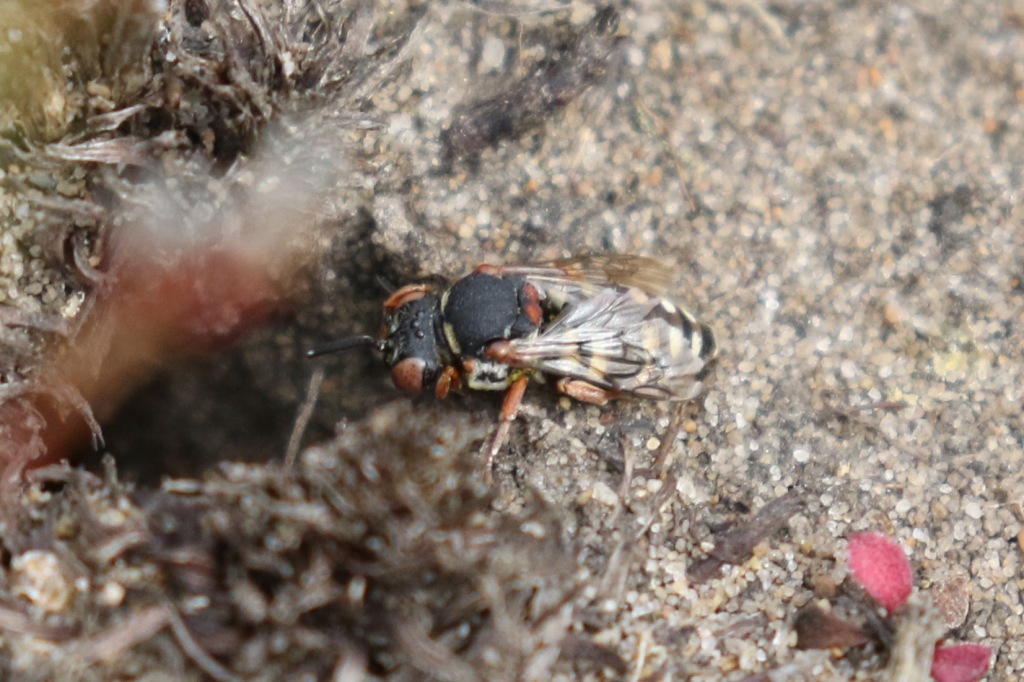
This was as far as we wanted to go up the Point today – it is about 1.5 miles from the beach car park at Cley to the Watch House, and another 1.5 miles further on to the old lifeboat house. Tough walking on what is largely shingle. Speaking to people who had been out further today, there was not a lot more to see in terms of migrants.
We decided to walk back along the beach and scan the sea on the way. About half way back, we noticed a Guillemot swimming past the other way, just offshore. The wind was still NNE, but not strong enough to blow anything in from out to sea this afternoon. We had the beach largely to ourselves – an amazing view looking back up the Point – until we got back to the beach car park at Cley. Then, after our exertions, we decided to call it a day.
